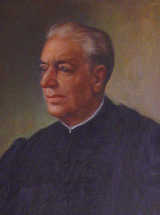U.Porto Memory
University of Porto Famous Alumni
Humberto de Almeida
 |
Humberto de Almeida 1896-1971 Engineer, university teacher, researcher and officer |
 Humberto Augusto de Almeida, son of Carlos Alberto de Lima and Elisa Augusta de Morais Almeida, was born in the parish of Santa Maria, in the district of Bragança, in 1896.
Humberto Augusto de Almeida, son of Carlos Alberto de Lima and Elisa Augusta de Morais Almeida, was born in the parish of Santa Maria, in the district of Bragança, in 1896.
After finishing high school in Bragança, he enrolled in the Faculty of Sciences of the University of Porto in the year 1914-1915.
In May 1916 he was summoned to attend the School for Non-Commissioned Officers, being called to integrate the Portuguese Expeditionary Corps (PEC) during the First World War. Between 1917 and 1918 he was in France, where he commanded the Headquarters of the 2nd Infantry Brigade and served as a liaison officer for the British Army.
After the end of the war, between 1920 and 1921, he took the Special Course of Infantry in the Military School, graduating on 7 October 1922.
The time he spent in the army granted him several praises, received in 1918, 1922, 1931 and 1938, and medals, such as the silver medal commemorating the Portuguese Army campaigns (1919) and the military silver medal for the exemplary behaviour class (1936).
He resumed his studies in the University of Porto in 1924, getting his degree in Physical-Chemical Sciences with a final mark of 16.4 and graduating in Chemical-Industrial Engineering with a final mark of 17.
In the school year of 1929-1930 he was appointed a temporary Professor of the 6th group in Alexandre Herculano High School and in 1930 he was hired, preceding a competition based on qualifications, to be an assistant of the 2nd group of the Faculty of Sciences of the University of Porto. The official nomination was made by charter of 23 June 1932 and by Diário de Governo n. 169, II Series, of 22 July 1932.
In April 1956, alongside Carlos de Brito, he participated in the examination for full Professor of Chemistry for the FCUP. In the exams, argued by Professors Mendonça Monteiro and Henrique Serrano, the candidate Humberto Almeida presented the lesson "Permutadores iónicos. Bases teóricas" ["Ionic Exchangers. Theoretical Bases"]. He was unanimously approved, with absolute merit, and came in second in relative merit.
In 1963, he was approved in the exams for full Professor of the 2nd section of the 2nd group – Chemistry for the FCUP.
 Besides being a University Professor, teaching subjects such as "General Notions of Chemical-Physics", he was also a prestige researcher. In 1938, appointed by Professor Pereira Salgado, he started collaborating in the scientific research projects in the laboratories of the Institute of Port Wine (today Institute of Porto and Douro Wines). Within the field of this research he published over two dozen papers. One of these studies – "Pesquisa do chumbo no vinho do Porto e em algumas bebidas estrangeiras" ["Research of lead in Port wine and in some foreign drinks"] -, presented in the International Congress of Agricultural Industries in Paris (1948), had a huge repercussion in the international defense of the brand Porto.
Besides being a University Professor, teaching subjects such as "General Notions of Chemical-Physics", he was also a prestige researcher. In 1938, appointed by Professor Pereira Salgado, he started collaborating in the scientific research projects in the laboratories of the Institute of Port Wine (today Institute of Porto and Douro Wines). Within the field of this research he published over two dozen papers. One of these studies – "Pesquisa do chumbo no vinho do Porto e em algumas bebidas estrangeiras" ["Research of lead in Port wine and in some foreign drinks"] -, presented in the International Congress of Agricultural Industries in Paris (1948), had a huge repercussion in the international defense of the brand Porto.
With a scholarship from the Institute for Advanced Culture he did internships in international faculties and laboratories. In the National Institute of Chemistry and Physics of Madrid he worked in the resolution of data concerning Polarography problems, which was the theme of his doctoral thesis ("Polarografia: análises polarográficas qualitativas e quantitativas aplicadas a soluções mais ou menos complexas", 1944) ["Polarography; qualitative and quantitative polarographic analysis applied to more or less complex solutions"], 1944) and, in Zurich, he studied the extraction and synthesis of vegetal dyers under the direction of Paul Karrer (1889-1971).
Several of his works, mostly in the areas of polarography and chromatography were quoted by renowned international scientists.
He died in 1971.
(Universidade Digital / Gestão de Informação, 2011)
Last updated: 2016-07-06 Webpage created on: 2024-10-06 11:29:13 Complaint Portal